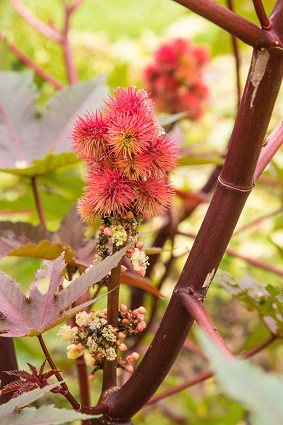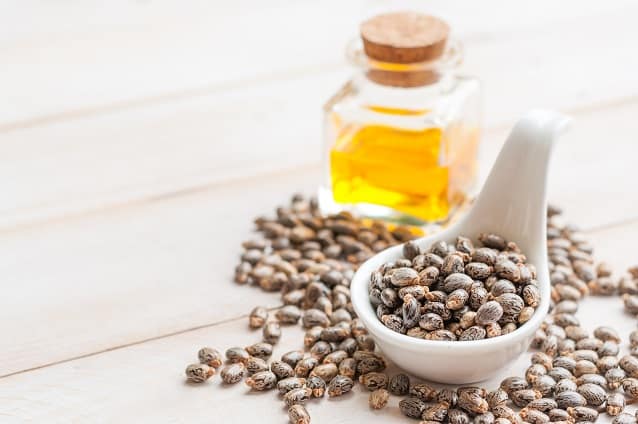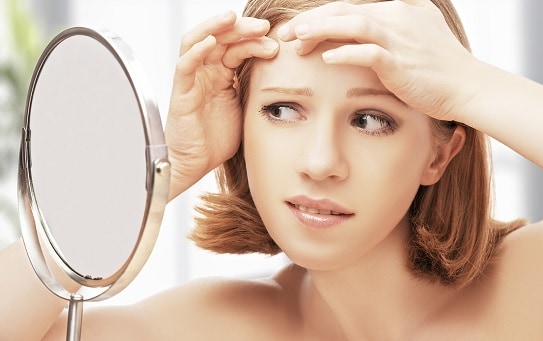
Alongside the massively effective and well researched kings of natural topical treatments like grapeseed oil, and green tea, one which remains highly mysterious is castor oil. It’s been experimented with endlessly, yet no studies have tested it directly on acne.
The oil is the fat extracted from the castor bean, itself the fruit of the ricinus communis plant. Egyptians have been using it for thousands of years; castor beans were found in Egyptian tombs dating back to 4000BC, while in the Ebers Papyrus medicinal text of 1500BC, castor oil was recommended for lowering eye irritation.
Topically, castor oil is an increasingly popular baldness solution, but overall, the castor plant is most famous as the natural source of ricin, the deadly, incurable poison featured in TV shows and delivered in envelopes to politicians everywhere. Castor oil is also a laxative, and was dished out by Mussolini and his fascist henchmen as a punishment back in the 1930s.
Castor oil is therefore distrusted by many, particularly the Italians. So understand right now that when applied to the skin, it’s completely safe. In 2002, it was found in over 769 cosmetic products, with lipstick accounting for 81%.
Rumours circulate the internet that castor oil contains vitamin E, lowers inflammation, and is a top notch moisturiser. The truth is that we don’t know the truth, because the research is too thin, but castor oil definitely has promise for acne.
Use castor oil – get 56 more minutes in the sun?
By far the best power is shielding your skin against the inflammation and irritation of UV radiation. Several natural topical treatments have this power, such as aloe vera, but not all – lemon juice contains natural furocoumarins which weaken your defences.
Our promising study for acne analysed the sun protection factor (SPF), a scientific measurement of a sunscreen’s effectiveness, both for sunburn and other skin irritation.
Here’s how it works. If your starting point is 10 minutes lying on a sandy beach in the sun, applying a rose oil cream with an SPF score of 1 will grant you an extra ten minutes free from burning. Applying a revolutionary new sunscreen with an SPF of 150, meanwhile, would give you an extra 1500 minutes.
Read Annihilate Your Acne – learn how to clear your skin permanently
The scientists tested ten fat-based oils (as opposed to essential oils like lavender oil, the leaves or petals of a plant distilled into a liquid), and castor oil received the sixth highest SPF, with a score of 5.687. The two strongest oils were olive oil with 7.549 and coconut oil with 7.119. Almond oil came in at 4.659. Two poor performers were sesame oil with 1.771 and mustard oil scoring 2.105.
Overall, castor oil landed at around the middle. At first glance, it looks average. However, 5.687 is an excellent score; it equals 56 extra minutes and 53 seconds on the beach before pimples explode from nowhere (bring your watch or else).
What’s more, coconut oil and olive oil are riddled with flaws. The former has a comedogenic rating of 4 out of 5, while the latter leads to irritated skin itself due to oleic acid.
The signs are strong for castor oil as a natural sunscreen. At first, there’s no obvious explanation. The first-ranking oils, olive oil and coconut oil, consist of 97% lauric acid and 70% oleic acid respectively. The average castor oil contains just 4% oleic acid with a 2-6% range, and no lauric acid at all.
So what’s the explanation then? Possibly that castor oil is a unique oil in nature. 90% of its total fats are a monounsaturated omega 9 called ricinoleic acid.
Ricinoleic acid is found in high quantities exclusively in the ricinus communis plant. It isn’t extensively researched, not compared to common fatty acids like oleic acid and linoleic acid.
Nobody knows what powers ricinoleic acid has. Therefore, UV ray protection could easily be one of them, and that could explain castor oil’s success.
Overall, if you were planning to use castor oil on your skin, a sunny day would be the best day to do it.
Can castor oil enhance every other topical treatment?
Next though, we have a completely fake power: the supposed fountain of vitamin E. There’s a strong tendency on skincare blogs to assume that any natural oil is rich in vitamin E, whether it’s jojoba oil or sesame seed oil, but castor oil contains precisely none.
This informative study on 17 different plant oils noted “as low as zero ug of a-tocopherol/g of castor bean and linseed oils and as high as 1276ug/g of wheat germ oil”. Alpha tocopherol is the main natural form of vitamin E. That theory is laid to rest, and while we’re here, we’ll get to wheat germ oil as a topical treatment another time.
However, the tables turn with our next study, which revealed that ricinoleic acid had potent anti-inflammatory properties, which matched the antioxidant capsaicin when applied to rat skin. Less inflammation equals less painful and red pimples; the ricinoleic acid content of castor oil varies from 85-95%.
Capsaicin is the spicy compound found in Chilli Peppers, which despite the burning and heat that make you vow never to eat one again, is strongly anti-inflammatory. Ricinoleic acid even reduced the dreaded substance P, a master regulator in acne which cranks up inflammation, sebum production, and skin cell turnover.
Even more promisingly, castor oil and ricinoleic acid might enhance the transdermal penetration of other skincare chemicals.
I first discovered that power in this review, and the origin turned out to be a study on rats performed in 1952. Therefore, unless you’re a giant rat sitting at a computer desk, the power is completely unconfirmed, but if real, the implications would be excellent.
Recommended – 6 vitamins and minerals which could finally clear your acne
Antibacterial peptides and compounds from raw honey would clear acne better. Mixing castor oil with witch hazel would enhance the skin’s absorption of its endless antioxidants. Combining castor oil with green tea would allow the latter to downregulate sebum production more efficiently. The possibilities would never end.
Last on the menu, we have moisturising. No direct studies exist, but castor oil lacks the side effects of olive oil or coconut oil. The oleic acid concentration is extremely low at 4%; oleic acid causes irritation and disrupts the skin barrier by increasing trans-epidermal water loss.
Furthermore, castor oil has a comedogenicity score of only 1 out of 5, indicating a “very low” chance of clogging skin pores. The fatty acid composition could secretly be ideal for moisturising, because like we said earlier, ricinoleic acid is an unexplored entity. The opposite is possible though – secret moisture-snatching powers.
The ricin scare story disproven
 Now, we have the ultimate question – is castor oil really laced with ricin, and can using it bring about an untimely demise? The answer is no.
Now, we have the ultimate question – is castor oil really laced with ricin, and can using it bring about an untimely demise? The answer is no.
You don’t even need science. Egyptians applied castor oil to their eyes back in 1500BC, and Indian women have used it since 2000BC. If castor oil contained ricin, an incurable poison which ranks among the most easily manufactured chemical warfare agents, there’d be a bloody trail carved through the history books. Indeed, there would be a bloody catalogue of tales on the internet, but there isn’t.
True, both ricin and castor oil are taken from the castor bean, but ricin is extracted from the crushed pulp once the oil has been separated.
In the traditional castor oil products which are heated for purification in a factory, all the ricin is deactivated anyway. I actually recommend that you buy cold-pressed, or expeller-pressed castor oil, but there’s still no problem. Ricin doesn’t partition into the oil during the initial separation from the bean; studies have confirmed this.
In fact, the FDA has deemed castor oil to be “generally recognised as safe” when taken orally. Topically, there’s even less danger.
7 natural topical treatments which can massively reduce acne
You will not come to a sticky end by using castor oil for acne. The bigger question is the milder side effects, such as skin irritation. This giant review concluded that castor oil was safe in the concentrations normally used in cosmetics and skincare.
Poor reactions do occur: “the clinical experience suggests that sensitization reactions are seen infrequently”. Existing dermatitis (an inflammatory skin condition) patients were most vulnerable, where castor oil and ricinoleic acid became mildly irritating and sensitising. In everyone else, however, castor oil caused no adverse sensitisation, photosensitisation, or irritation.
The scientists also considered ricinoleic acid to be fair game for their review, since it comprises 90% of castor oil. The result: “the available data demonstrate few toxic effects”.
Castor oil has no specific irritating compounds, like the 8-cineol of tea tree oil. In the real world, I’ve seen several negative testimonials speaking of new pimples, but no more than with grapeseed oil or jojoba oil.
The only much-feared side effect is dry skin; castor oil is said to be a “drying oil” which sucks all the moisture away. However, nothing of the sort was mentioned in the study above.
Whether castor oil cures acne remains to be seen, but there’s little risk in trying it.
Is castor oil a miracle hair-growth tonic?
If you believe some, however, any castor oil applied to your face is wasted anyway. Quite simply, it’s believed that rubbing unheated castor oil into your scalp will stimulate the inactive hair follicles to start growing again.
It’s gaining popularity rapidly in the hair loss community, as a natural alternative to harsh drugs like finasteride. People are even using castor oil to regrow their eyebrows (hopefully they won’t become a metre long).
Is there any truth to it? There’s definitely some evidence. According to this 2005 study, a compound called prostaglandin E2 had a stimulatory effect on hair growth. Specifically, it co-ordinated with another compound called PGF2alpha; PGE2 didn’t convert inactive hair follicles to active ones, but it did accelerate those in the early stages of rebirth.
The connection? This study found that eating castor oil increased PGE2 levels significantly in rats.
We don’t know whether this translates when applied topically, or in humans, and the rise in PGE2 might not be significant enough. But the purported benefits of castor oil for hair growth came from testimonials originally, and this could be an explanation.
There’s also a similar compound called prostaglandin D2, which prevents hair follicle activation, and it’s speculated though not proven that ricinoleic acid decreases it. The vitamin E is another theory, since this study found that naturally occurring forms called tocopherols could stimulate hair growth. But again, there is no vitamin E in castor oil.
Overall, the jury is out on whether castor oil will give you a head of hair like Conan the barbarian, or Rapunzel if you’re a woman with hair loss.
The jury isn’t out on two much more common foods though: garlic and onions.
Apparently, onion juice is one of greatest treatments for hair loss around, hidden right in front of our eyes. This study was extremely basic, yet very interesting. 38 patients with hair loss were divided into a tap water group or a crude onion juice group, which they applied twice daily.
Why aloe vera is the nemesis of red and inflamed acne
In the onion juice group, regrowth of hair commenced after just two weeks. After four weeks, hair regrowth was observed in 17 (73.9%) patients, and 20 after six weeks (86.9%). Meanwhile, only two (13%) people stuck in the tap water group experienced hair growth after 8 weeks.
Why on earth could this transformation have occurred? It could have been anything. Onion is a highly nutritious food; quercetin is one phytonutrient which it’s packed with.
But the onion is in the same botanical family as the garlic bulb, and garlic is another hair-sprouting secret. In this study, 19/20 people applying garlic gel experienced a “good” increase in hair regrowth and 1 experienced a “moderate” increase. This significantly outperformed 20 people applying a placebo gel.
If you want to restore your long lost hair, then just open your cupboard door and grab some onions, garlic and a chopping board.
There’s also zinc supplements, for maintaining the integrity of the hair follicles, and increasing your intake of glycine, to provide more structural proteins. Zinc also happens to be excellent for acne.
The verdict on castor oil
 Overall, castor oil is an interesting natural topical treatment for acne, which I won’t pass judgement on yet. Castor oil remains shrouded in mystery. There could be anti-inflammatory powers due to the ricinoleic acid, and it could be a great moisturiser.
Overall, castor oil is an interesting natural topical treatment for acne, which I won’t pass judgement on yet. Castor oil remains shrouded in mystery. There could be anti-inflammatory powers due to the ricinoleic acid, and it could be a great moisturiser.
However, we know for certain that the vitamin E content is a myth. We know that its safety record is good to great. The only risk is that you’ll wake up and be the Wolfman, if you apply it to your face and the hair loss community turns out to be overly accurate.
Sun protection is the best supported power. If it doesn’t clear acne, then castor oil might successfully prevent it.
Castor oil could therefore be a handy oil to keep in your cupboard over the summer, or bring on a beach holiday where the sun beats down on you mercilessly. Remember: castor oil can increase your time spent in the sun without irritation by 56 minutes per 10 minutes. That’s a pretty interesting power.
I won’t issue an official Supernatural Acne Treatment recommendation, but castor oil has a lot of promise, not least because its abundant ricinoleic acid has barely any research. If you want to discover the truth for yourself, then Sky Organics Cold-Pressed Castor Oil is an excellent brand.
Classic vs Jamaican black castor oil
Now it’s time to become an expert on the different types of castor oil. For maximum skin-enriching value, there are unique twists and turns compared to say, jojoba oil.
Specifically, you have the choice of either classic castor oil or Jamaican black castor oil.
Classic castor oil is the norm, and the cold-pressed variety which you should purchase has a light gold colour. Compared to cold pressed oils like sea buckthorn or jojoba oil, it isn’t that dark, but it will have that natural glow to it.
Organic cold pressed is optimal, since conventional refined oil features the usual cocktail of hexane and factory chemicals. During cold-pressing, the temperature never rises above the safe level of 50 degrees. Meanwhile, refined castor oil is blasted with heat until it’s swimming with free radicals, dreaming of giving you acne.
Refined castor oil is also bleached with chemicals to remove the colour. Why the manufacturers would want to is unknown – if I were the CEO, I’d retain the colour to make some extra sales based on appearance. Regardless, the chemicals will deliver inflammation and free radical mayhem to your skin.
As for black Jamaican castor oil, avoid getting dealt this stuff. It’s called black castor oil because that’s what it is – the Jamaican manufacturers roast the castor beans for an extended period of time to produce a black colour and burnt smell. It’s still manufactured in the Jamaican heartland and is a centuries old tradition.
Unfortunately, foreign items such as ash are introduced to the mix during production. An added acne risk has never been confirmed, but heating an oil for hours is never a smart decision; the longer the exposure, the greater the oxidation of fats and nutrients.
It’s also possible that roasting the beans frees acne-friendly phytonutrients and antioxidants from molecular bindings, like with steamed broccoli. One confirmed change is a higher PH compared to normal castor oil.
Overall though, if you do decide to experiment with castor oil, your choice is clear – cold-pressed classic castor oil.
NEXT: forget creams and moisturisers – discover the ultimate acne-clearing diet
Thanks for reading!